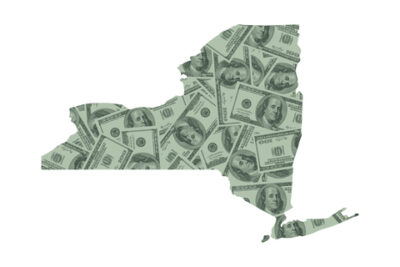 New research has revealed the states with the biggest improvements in their debt-to-income ratios when comparing the 2013 and 2023 figures – with New York and Connecticut both top 10.
New research has revealed the states with the biggest improvements in their debt-to-income ratios when comparing the 2013 and 2023 figures – with New York and Connecticut both top 10.
The study by business accounting experts Avenues Financial analyzed data from the Federal Reserve to determine the percentage change in the debt-to-income ratio (DTI) in each state for the years in question.
Avenues Financial then ranked the states from those with the biggest decreases in their DTI ratios, closing the gap and improving their debt position, to the states with the largest increases in their DTI ratios and thus the biggest losses to their debt position.
Home to the financial capital of the United States, New York ranked fifth – with a 12.36% improvement in its DTI ratio, according to the findings. As of 2023, New York had the lowest DTI ratio in all 50 states at just 1.028. This is an improvement compared to 10 years ago, despite that figure being only 1.173 in 2013.

| Dreamstime.com
Connecticut came in at eighth, with a 10.19% improvement in its DTI, from 1.62 in 2013 to 1.455 in 2023.
But it is Washington state that had the biggest comeback in its debt-to-income ratio, with a 19.23% decrease over the last decade. While Washington had a DTI ratio of 2.033 in 2013 (fifth highest in the United States at the time), it experienced huge improvements, seeing a 1.642 ratio in 2023.
Illinois came in second, with the state’s debt-to-income ratio improving by 15.19% over the period analyzed. According to the study, Illinois’s 2023 DTI ratio of 1.223 ranked fifth in the U.S. for those with the lowest ratios – 20% lower than the state average identified. This contrasts with Illinois’s DTI ratio of 1.442 from 10 years prior.
California scored the third-biggest debt comeback between 2013 and 2023 – experiencing a 14.52% reduction. The state’s 2013 DTI ratio was 2.087 but improved to 1.784 in 2023.
Virginia had the fourth-biggest DTI ratio improvement with a 13.63% decrease. In 2023, Virginia had a DTI ratio of 1.837 – down from 2.127 in 2013, which was the third highest in the U.S. at the time.
Rounding out the top 10 states with the biggest debt-to-income ratio improvements were Vermont in sixth place, followed by Maryland in seventh, Maine in ninth and New Jersey in 10th.
Keep in mind that the study measured percentage increase or decrease, not who had the best DTI ratio. In 2013, North Dakota had the lowest and, therefore, the best DTI ratio compared to all states at just 0.818. While its ratio remained low at 1.156 in 2023, this equates to a huge 41.32% increase. This is by far the biggest increase identified across the U.S. and ranks the state as having the biggest debt loss over the decade — even though that loss may be less than other states that nonetheless improved their DTI ratio.
Texas experienced the second-biggest increase in its DTI ratio in the country — a 17.22% increase from 1.15 to 1.348. The state with the third-biggest loss to its DTI ratio was Louisiana. The study found that in 2013, the state had a DTI ratio of 1.303, which jumped to 1.469 in 2023 — a 12.74% increase.
Wyoming and Oklahoma rankws fourth and fifth as the findings revealed that their DTI ratios increased by 7.99% and 6.28% respectively..
Nicole Jensen, CPA, co-founder, and Chief Financial Officer of Avenues Financial, said of the study:
“These findings show how some states have really turned things around when managing debt. Reducing a state’s debt-to-income ratio is crucial for long-term financial stability. With less debt, governments can invest more in essential services like health care and infrastructure rather than paying high interest costs.
“Washington’s impressive drop in its debt-to-income ratio is a great example of how smart financial choices can make a big difference. This data serves as a reminder for everyone about the importance of keeping an eye on our finances and making informed decisions for a brighter financial future.”





















